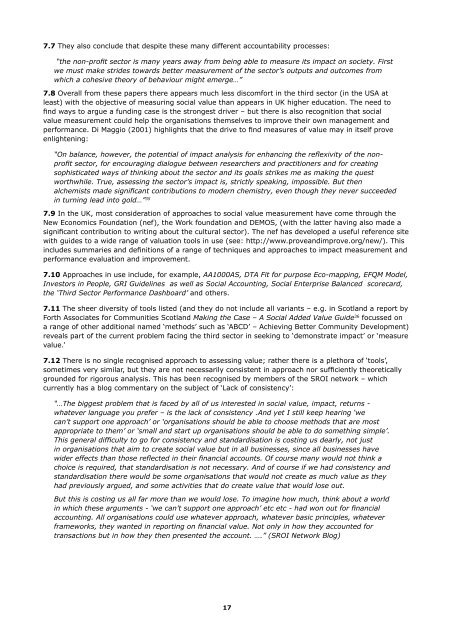Through a glass darkly Measuring the social value of universities
80096 NCCPE Social Value Report (2)
80096 NCCPE Social Value Report (2)
- No tags were found...
Create successful ePaper yourself
Turn your PDF publications into a flip-book with our unique Google optimized e-Paper software.
7.7 They also conclude that despite <strong>the</strong>se many different accountability processes:“<strong>the</strong> non-pr<strong>of</strong>it sector is many years away from being able to measure its impact on society. Firstwe must make strides towards better measurement <strong>of</strong> <strong>the</strong> sector’s outputs and outcomes fromwhich a cohesive <strong>the</strong>ory <strong>of</strong> behaviour might emerge…”7.8 Overall from <strong>the</strong>se papers <strong>the</strong>re appears much less discomfort in <strong>the</strong> third sector (in <strong>the</strong> USA atleast) with <strong>the</strong> objective <strong>of</strong> measuring <strong>social</strong> <strong>value</strong> than appears in UK higher education. The need t<strong>of</strong>ind ways to argue a funding case is <strong>the</strong> strongest driver – but <strong>the</strong>re is also recognition that <strong>social</strong><strong>value</strong> measurement could help <strong>the</strong> organisations <strong>the</strong>mselves to improve <strong>the</strong>ir own management andperformance. Di Maggio (2001) highlights that <strong>the</strong> drive to find measures <strong>of</strong> <strong>value</strong> may in itself proveenlightening:“On balance, however, <strong>the</strong> potential <strong>of</strong> impact analysis for enhancing <strong>the</strong> reflexivity <strong>of</strong> <strong>the</strong> nonpr<strong>of</strong>itsector, for encouraging dialogue between researchers and practitioners and for creatingsophisticated ways <strong>of</strong> thinking about <strong>the</strong> sector and its goals strikes me as making <strong>the</strong> questworthwhile. True, assessing <strong>the</strong> sector’s impact is, strictly speaking, impossible. But <strong>the</strong>nalchemists made significant contributions to modern chemistry, even though <strong>the</strong>y never succeededin turning lead into gold…” 357.9 In <strong>the</strong> UK, most consideration <strong>of</strong> approaches to <strong>social</strong> <strong>value</strong> measurement have come through <strong>the</strong>New Economics Foundation (nef), <strong>the</strong> Work foundation and DEMOS, (with <strong>the</strong> latter having also made asignificant contribution to writing about <strong>the</strong> cultural sector). The nef has developed a useful reference sitewith guides to a wide range <strong>of</strong> valuation tools in use (see: http://www.proveandimprove.org/new/). Thisincludes summaries and definitions <strong>of</strong> a range <strong>of</strong> techniques and approaches to impact measurement andperformance evaluation and improvement.7.10 Approaches in use include, for example, AA1000AS, DTA Fit for purpose Eco-mapping, EFQM Model,Investors in People, GRI Guidelines as well as Social Accounting, Social Enterprise Balanced scorecard,<strong>the</strong> ‘Third Sector Performance Dashboard’ and o<strong>the</strong>rs.7.11 The sheer diversity <strong>of</strong> tools listed (and <strong>the</strong>y do not include all variants – e.g. in Scotland a report byForth Associates for Communities Scotland Making <strong>the</strong> Case – A Social Added Value Guide 36 focussed ona range <strong>of</strong> o<strong>the</strong>r additional named ‘methods’ such as ‘ABCD’ – Achieving Better Community Development)reveals part <strong>of</strong> <strong>the</strong> current problem facing <strong>the</strong> third sector in seeking to ‘demonstrate impact’ or ‘measure<strong>value</strong>.’7.12 There is no single recognised approach to assessing <strong>value</strong>; ra<strong>the</strong>r <strong>the</strong>re is a plethora <strong>of</strong> ‘tools’,sometimes very similar, but <strong>the</strong>y are not necessarily consistent in approach nor sufficiently <strong>the</strong>oreticallygrounded for rigorous analysis. This has been recognised by members <strong>of</strong> <strong>the</strong> SROI network – whichcurrently has a blog commentary on <strong>the</strong> subject <strong>of</strong> ‘Lack <strong>of</strong> consistency’:“…The biggest problem that is faced by all <strong>of</strong> us interested in <strong>social</strong> <strong>value</strong>, impact, returns -whatever language you prefer – is <strong>the</strong> lack <strong>of</strong> consistency .And yet I still keep hearing ‘wecan’t support one approach’ or ‘organisations should be able to choose methods that are mostappropriate to <strong>the</strong>m’ or ‘small and start up organisations should be able to do something simple’.This general difficulty to go for consistency and standardisation is costing us dearly, not justin organisations that aim to create <strong>social</strong> <strong>value</strong> but in all businesses, since all businesses havewider effects than those reflected in <strong>the</strong>ir financial accounts. Of course many would not think achoice is required, that standardisation is not necessary. And <strong>of</strong> course if we had consistency andstandardisation <strong>the</strong>re would be some organisations that would not create as much <strong>value</strong> as <strong>the</strong>yhad previously argued, and some activities that do create <strong>value</strong> that would lose out.But this is costing us all far more than we would lose. To imagine how much, think about a worldin which <strong>the</strong>se arguments - ‘we can’t support one approach’ etc etc - had won out for financialaccounting. All organisations could use whatever approach, whatever basic principles, whateverframeworks, <strong>the</strong>y wanted in reporting on financial <strong>value</strong>. Not only in how <strong>the</strong>y accounted fortransactions but in how <strong>the</strong>y <strong>the</strong>n presented <strong>the</strong> account. ….” (SROI Network Blog)17


